How To Get Rid Of Static Hair Using 11 Simple Tips
Easy tips and hacks to deal with this hair issue and keep your locks tangle-free.
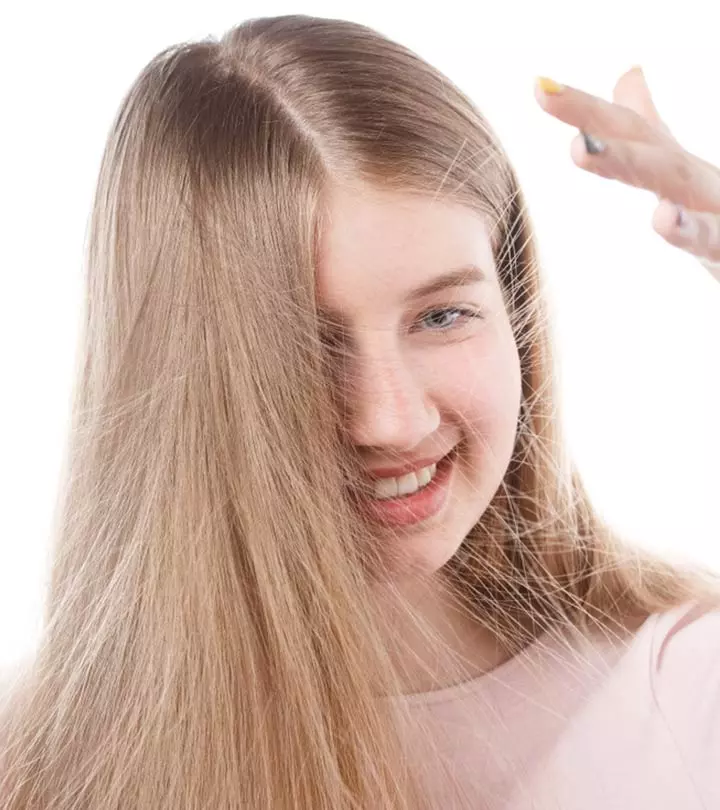
Image: Shutterstock
Have you ever encountered that hair-raising experience when your hair rubs against a woolen sweater? This is due to static hair, and you can observe this mostly during winters. But how to get rid of static hair? Because static hair can ruin your perfect hair look. This happens when your hair gets charged with static electricity. In this state, the hair strands can repel each other due to the positive charge. But the good news is that you can easily deal with static hair with some simple hacks.
This article explores the causes of static hair, simple hair hacks to get rid of it, and some products and other hair tips that can combat it. Take a look.
In This Article
Causes Of Static Hair
When two objects rub against each other, one loses its electrons and becomes positively charged, while the other gains electrons and becomes negatively charged. That is static electricity. But why is my hair so staticky?
Your hair contains electrons, making it the perfect conductor of static electricity. When it rubs against another object, like wool or a balloon, the hair loses its electrons and is left with positive charge, causing all the hair strands to fly away from each other.
This phenomenon is common during winters because the dry winter air has no humidity or moisture, causing the electrons to charge up. In addition, all those cute scarves, hooded jackets, and winter apparel you wear can make your hair lose electrons and go crazy. And things can escalate quickly for those with fine hair.
Many people confuse static hair with frizzy hair. Learn the difference between the two in the next section.
Key Takeaways
- Avoid wearing synthetic, nylon, and polyester materials if your hair is prone to static. Change to cotton or silk clothing.
- Use hair conditioner during winters, as dry and frizzy winter hair is more susceptible to static electricity.
- Spray the hairspray into a comb and drag it through your hair to keep frizzy hair at bay, prevent static electricity, and evenly distribute the product.
- Use hydrating hair masks, shampoos, or serums with ingredients like coconut milk, avocado, banana, and shea butter to keep your hair moisturized.
Static Hair Vs. Frizzy Hair
Although the culprit behind both frizzy hair and static hair is moisture, there is a significant difference between them.
Static hair is caused by positive and negative ionic imbalances in dry climate conditions. It is characterized by dull, dry hair flyaways and split ends. In some cases, the static may also cause strain on the scalp. It can be treated with moisturizing hair products and using pillows, clothes, and hair accessories made of anti-static materials.
On the other hand, frizzy hair occurs when humidity and heat damage the hair cuticles and make them dry. This hair type is characterized by coarse, unruly, and untamed strands that stand out from the rest and are difficult to manage. They can be treated with anti-frizz, deeply moisturizing products and by avoiding heat exposure.
Let’s not allow this static electricity to get on your head (literally!) and see what you can do to get rid of it.
How To Get Rid Of Static Hair
If you are wondering how to remove static from hair, try using a hydrating conditioner, avoid over-drying with heat styling tools, and incorporate anti-static products into your hair care routine. Here are some detailed tips to get rid of staticky hair.
1. Switch To Ionic Hair Dryers

Ionic hair dryers dry your hair and cause lesser hair damage than the regular blow dryers. These styling tools emit negative ions that separate water molecules into smaller particles, enabling faster evaporation. The negative ions cling to their positively charged counterparts, causing a neutralizing effect, and balance the electrons in your hair. This reduces friction and keeps your hair free of static.
2. Use A Leave-In Hair Conditioner
Your hair loses moisture and turns frizzy and dry in winter, making it prone to static electricity. Adding a conditioner to your hair care regimen can prevent this. Conditioners impart moisture to your locks and eliminate existing static (1).
Conditioners also protect your hair from changing climatic conditions during summer, winter, and rainy seasons that may increase static in your hair. Make sure you spread the conditioner across your hair using a comb. Even distribution of the product keeps your hair tangle-free.
 Quick Tip
Quick Tip3. Spritz A Hairspray

Spray the hairspray onto a comb (wooden or metal, preferably) and run it through your hair. This keeps the flyaways in place, prevents static electricity, and spreads the product evenly across your hair.
Be mindful – don’t overdo the process. Excessive use of hairspray can damage your locks. You can use hairsprays that are formulated to bring down static. Even water can help control static electricity and flyaways.
Rosemary, a blogger, shared how she tames her hair while blow drying it. She writes, “ I used to wake up after a blow dry with the ends of my hair all stuck together, hair sticking out at weird angles… but using a natural wood comb has made all the difference (i).”
Handy Tip: If you are heading out for a meeting and your hair looks frizzy and wild, spritz some water on your tresses. This will smoothen the strands and keep your hair under control.
4. Use Moisturizing Hair Products

Dry hair is highly prone to static. Use moisturizing hair masks, shampoos, or serums containing hydrating ingredients like coconut milk, avocado, banana, glycerin, aloe vera, and shea butter. These ingredients work exceptionally well in winters and help moisturize and soften dry and brittle hair and minimize static.
Also, avoid using products containing alcohol as it has a drying effect on your scalp and hair.
5. Avoid Using Plastic Combs
Using plastic combs is like feeding static to your hair. Switch to wooden, metallic, or ceramic combs. Metallic combs are the best as they pick static from your hair and attach it to themselves. You can also purchase an anti-static comb that eliminates the built-up static. Wide-toothed wooden combs and boar bristle brushes can help as they do not produce any static effect.
6. Apply Nourishing Hair Oils

Dry and brittle hair is prone to static as it lacks moisture. Moisturizing oils like natural coconut, jojoba, olive, almond, and argan oils can work like magic to prevent static. Apply a few drops of any of these oil to the dry ends of your hair and brush gently. Follow this procedure before blow-drying or straightening your hair. You can also drench your hair strands with these oils to tame flyaways and frizz and maintain smoothness and shine.
7. Rub Dryer Sheets On Your Pillow
The hair strands that you find sticking to the pillows and sheets after a good night’s sleep are a sign of static buildup on their surface. The hair can pick up static when it rubs against other materials. You can prevent this by rubbing a dryer sheet on your pillow or wiping your hair with it. You can also swipe these sheets onto your hairbrush before combing your hair. For better results, keep a pack of dryer sheets handy in your bedroom, closet, and dressing room.
8. Avoid Wearing Synthetic And Nylon Clothes
If your hair is prone to static, avoid wearing synthetic, nylon, and polyester materials as they carry a static charge and transfer it to your hair. Switch to cotton or silk clothes. Also, start using microfiber towels for drying your hair as they have excellent water-absorbing power. Microfiber towels also reduce the drying time of your hair, minimizing the blow drying time and heat damage.
 Did You Know?
Did You Know?9. Avoid Shampooing Every Day
Shampooing your hair every day can strip your scalp of natural oils. This can dry your hair and turn it brittle. Shampoo two or three times a week with an intense moisturizing shampoo to avoid static. Follow up with a silicone-based conditioner to keep static at bay. Silicone creates a layer on the hair strands that prevents static electricity and adds shine.
10. Braid Your Hair
This is a simple solution for long hair. Slick your hair back into a bun or braid it before going to bed. This prevents the hair strands from rubbing against the pillow, minimizing the possibility of static buildup in the morning. For better results, use anti-static serums to fasten the buns.
11. Try To Avoid Heat Styling Tools
Heat styling tools can further dry your hair and create more static within your strands. If you cannot avoid it altogether, try to reduce the temperature or use a good heat protectant to keep your hair from getting fried. Use heat-free styling products like setting sprays, hair mousse, and gels.
12. Use A Humidifier
Dry air, especially in winter, contributes to static electricity. Using a humidifier may increase the moisture levels in your home, creating a more hair-friendly environment. Keeping the air sufficiently humid can prevent your hair from becoming dry and static-prone in the first place.
What Are The Products To Combat Static Hair?
There are several products available on the market that specifically deal with static hair. From leave-in conditioners and static control mists to hairsprays and creams – pick one that suits your hair type. The key is to use the right product as per your hair type.
For Fine Hair
- Lightweight leave-in conditioners that hydrate without weighing your hair down should be your go-to. Look for formulas designed to add moisture and tame flyaways without making your hair look limp.
- Anti-static mists that provide hydration while maintaining a natural finish may help reduce static for fine strands.
For Curly Hair
- Curl creams or styling smoothies, rich in moisturizing ingredients like shea butter or coconut oil, not only define your curls but also combat dryness and static.
- Alcohol-free mousses or foams help control static without stripping moisture, keeping your curls soft and bouncy.
For Thick Hair
- Rich hair oils or serums are perfect for sealing in moisture and smoothing down static-prone strands. Go for products that are lightweight enough to avoid a greasy look but still provide deep hydration.
- Anti-frizz sprays formulated for thicker hair can create a protective barrier against static, especially in dry or cold weather.
For more suggestions on anti-static hair care products, click right here.
Infographic: Quick Tips And Fixes To Combat Static Hair
Your hair needs extra care and attention during the winter season to avoid static. To minimize this issue during colder months, you need to make a few changes in your hair care routine, like switching from plastic combs to metal combs, avoiding hair styling products with alcohol, using microfiber towels, trying out hair remedies, and many more.
Check out the infographic below to know more such tips and quick fixes that will help you get rid of static hair. Illustration: StyleCraze Design Team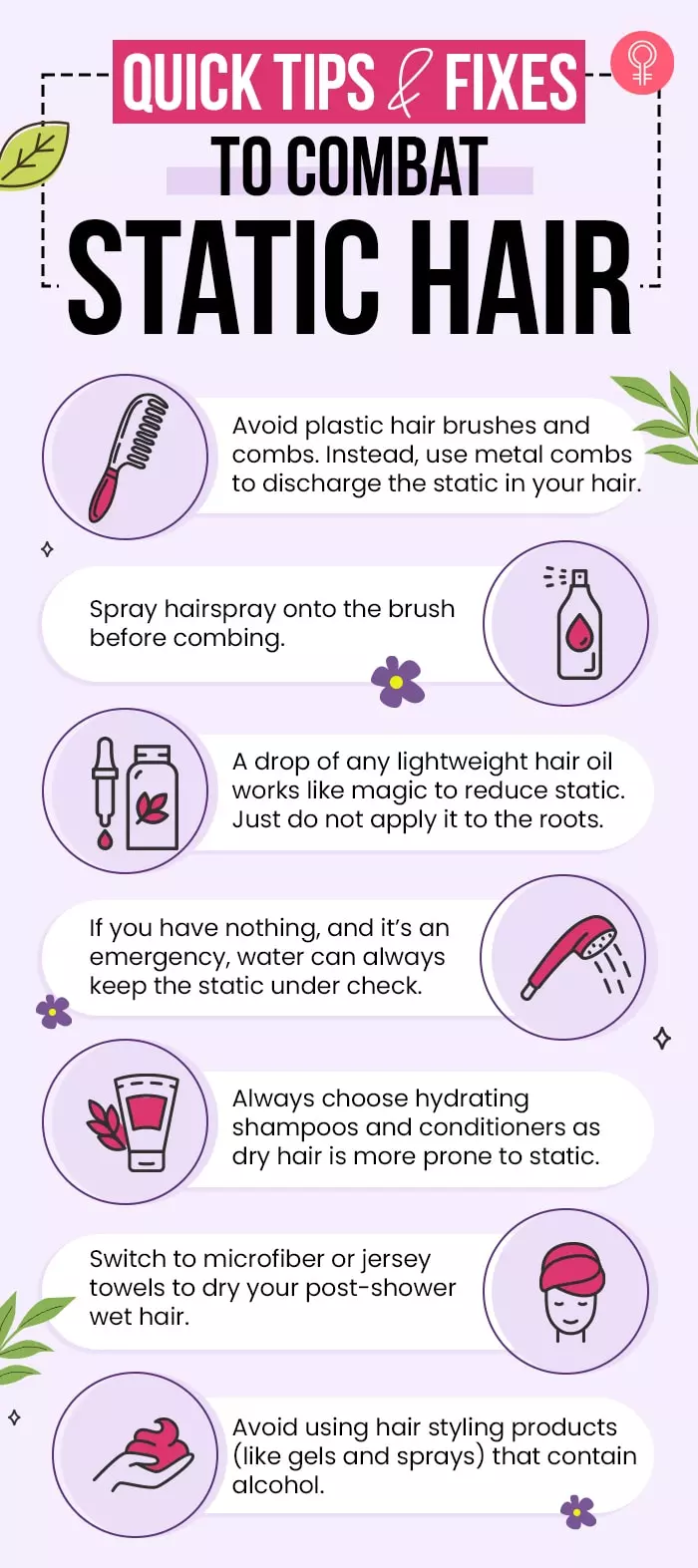
Static hair is common during winters. It often ruins the perfect hair look. However, you can manage static hair using ionic hair dryers, moisturizing hair products, leave-in hair conditioners, and spraying hair spray on the comb before running it through the hair. Also, avoid plastic combs, apply nourishing oils, and avoid nylon and synthetic clothes to manage static hair. In addition, braiding your hair, avoiding shampooing every day, and minimizing the usage of heat styling tools help minimize the static hair. We hope these tips will help you manage static in your hair and flaunt your beautiful hairstyle.
Frequently Asked Questions
Is static hair unhealthy?
While it is not unhealthy, it may make your hair dry and brittle if not taken care of.
Why does my body have so much static?
Human skin, hair, wool, and glass can accumulate a static electric charge, especially in dry and dehydrated surroundings. Carpets and socks can add to the static electricity.
Does coconut oil help with static hair?
Yes, using coconut oil can help tame static. Take some coconut oil in your hands and rub it between your palms. Apply it lightly to the hair strands to reduce the static.
Can dehydration cause hair static?
Yes, dehydration in your body and surrounding air can lead to your hair strands getting dry and developing static easily.
Illustration: How To Get Rid Of Static Hair Using 11 Simple Tips
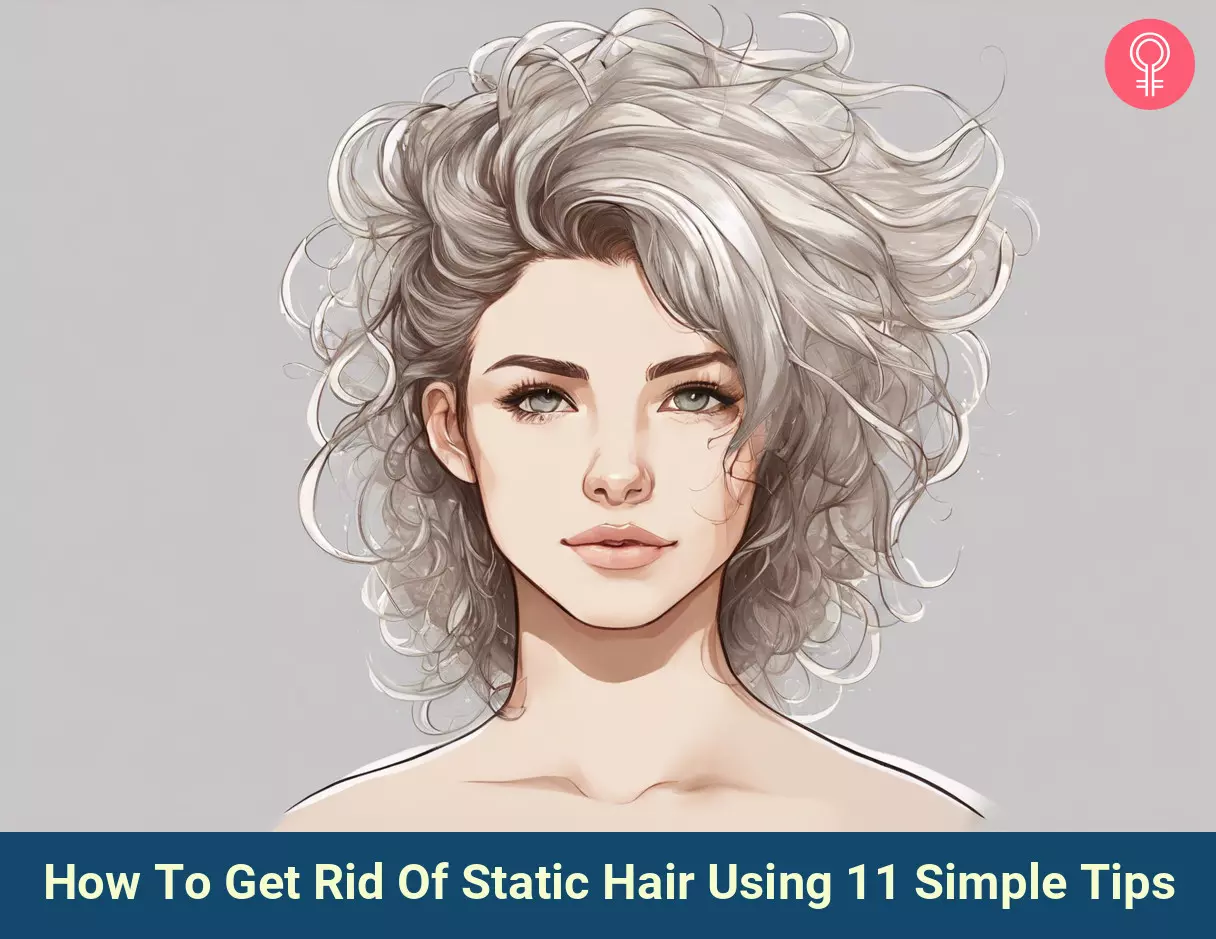
Image: Stable Diffusion/StyleCraze Design Team
Tired of dealing with unruly and stubborn static hair? Check out this video to learn simple tips on keeping your hair sleek and under control.
Personal Experience: Source
StyleCraze's articles are interwoven with authentic personal narratives that provide depth and resonance to our content. Below are the sources of the personal accounts referenced in this article.
i. The girl with the magic comb,https://lashesandlattesdotcom.wordpress.com/2012/07/08/the-girl-with-the-magic-comb/
References
Articles on StyleCraze are backed by verified information from peer-reviewed and academic research papers, reputed organizations, research institutions, and medical associations to ensure accuracy and relevance. Read our editorial policy to learn more.
- Hair Cosmetics: An Overview
https://www.ncbi.nlm.nih.gov/pmc/articles/PMC4387693/
Read full bio of Dr. Shruti Chavan
Read full bio of Arshiya Syeda
Read full bio of Ramona Sinha
Read full bio of Medha Deb






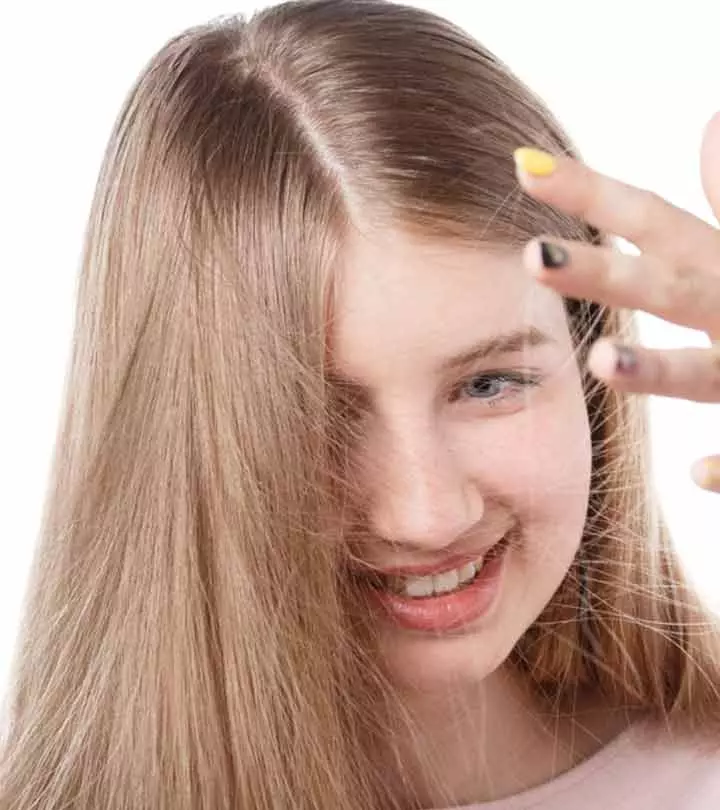
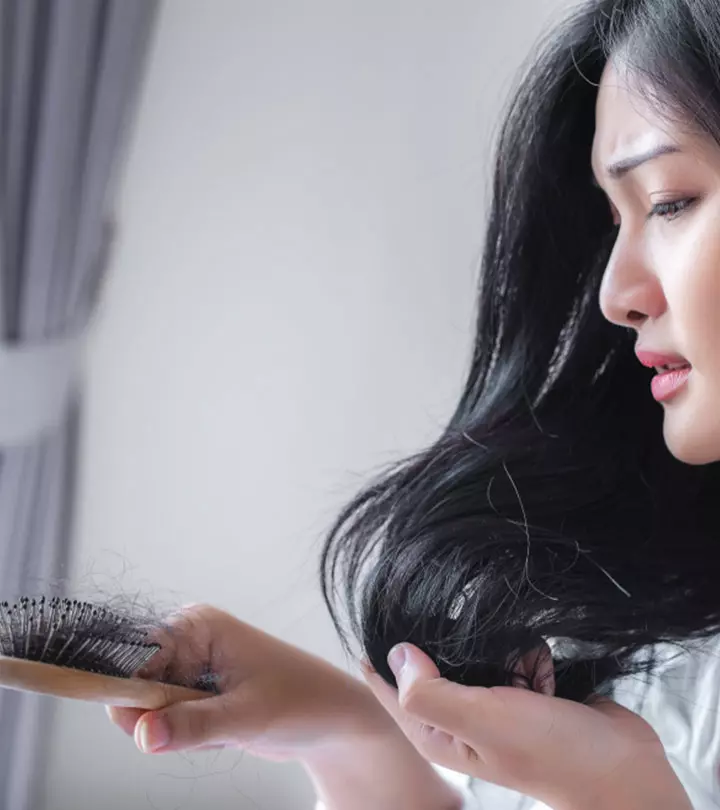

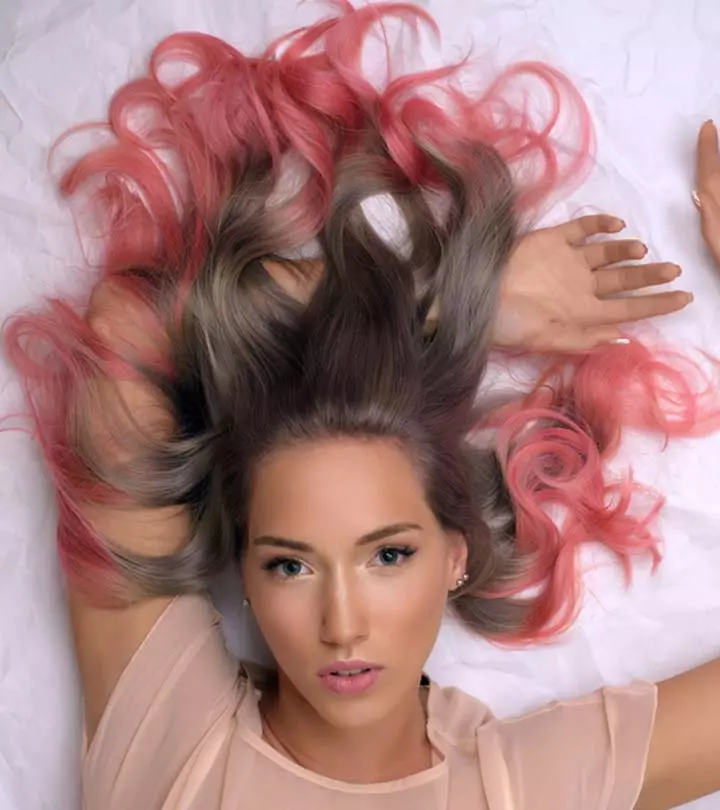


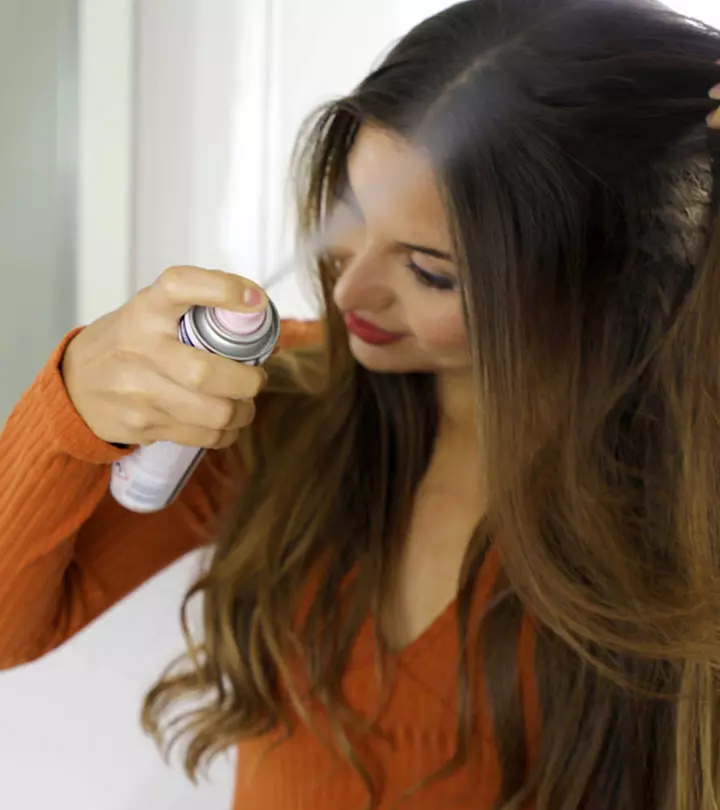

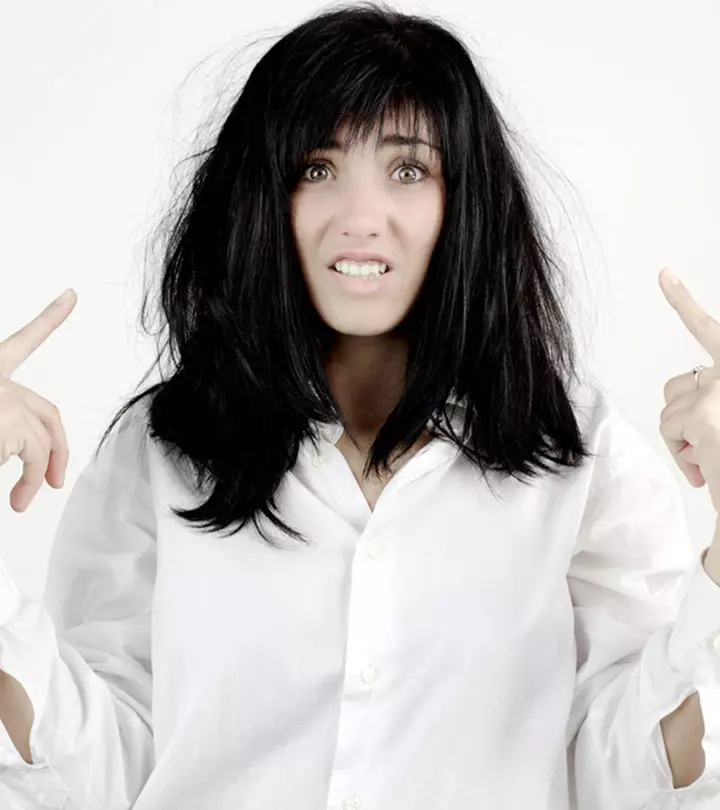
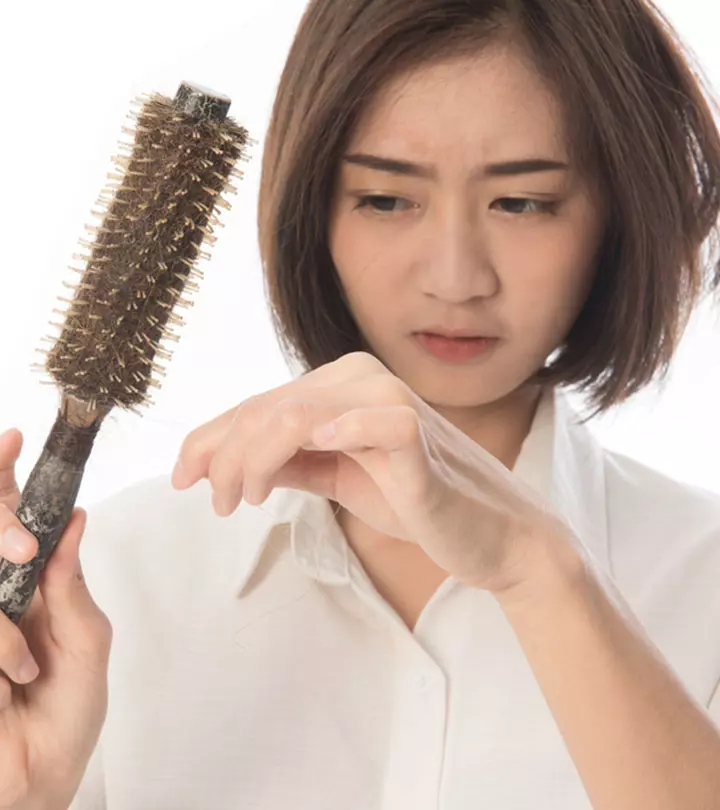
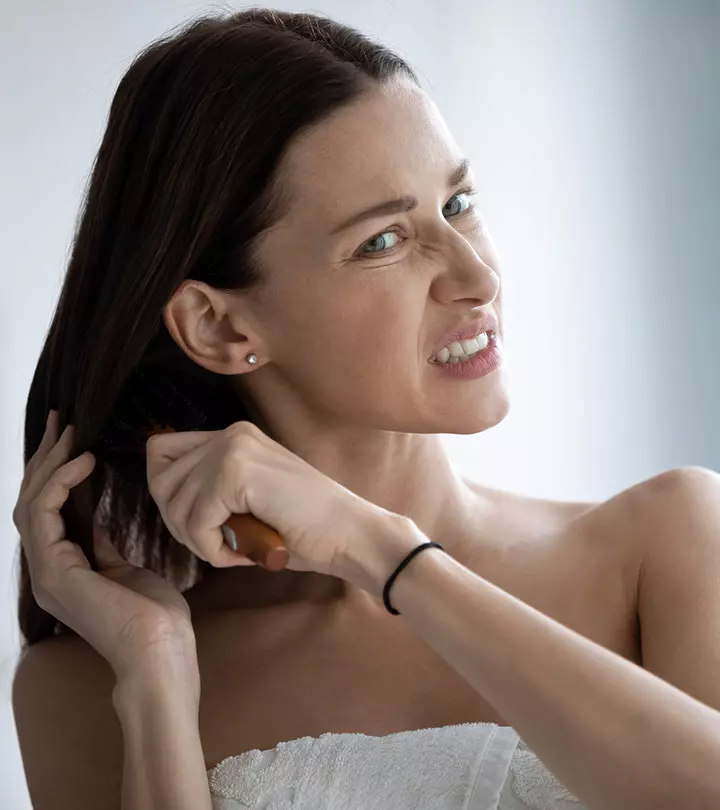
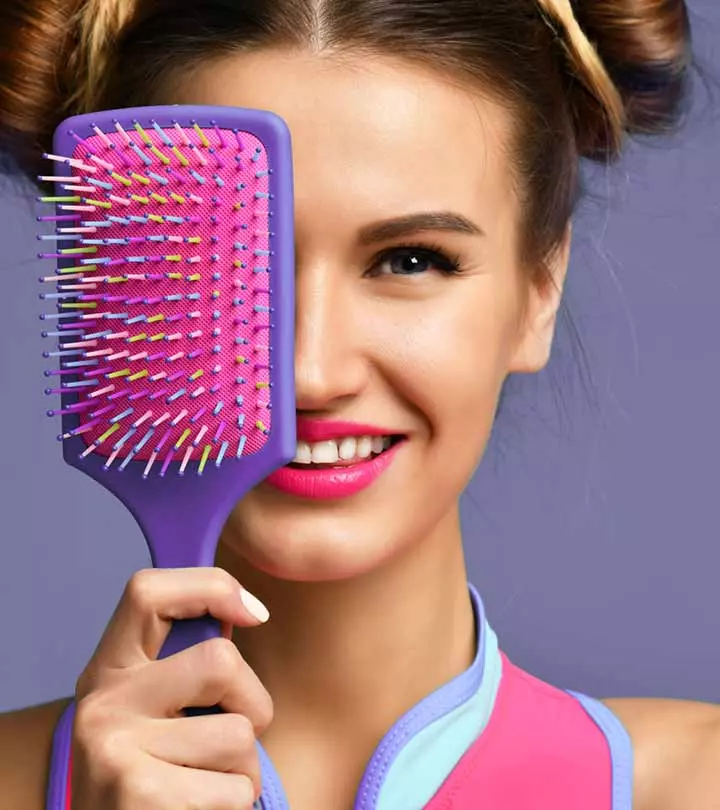

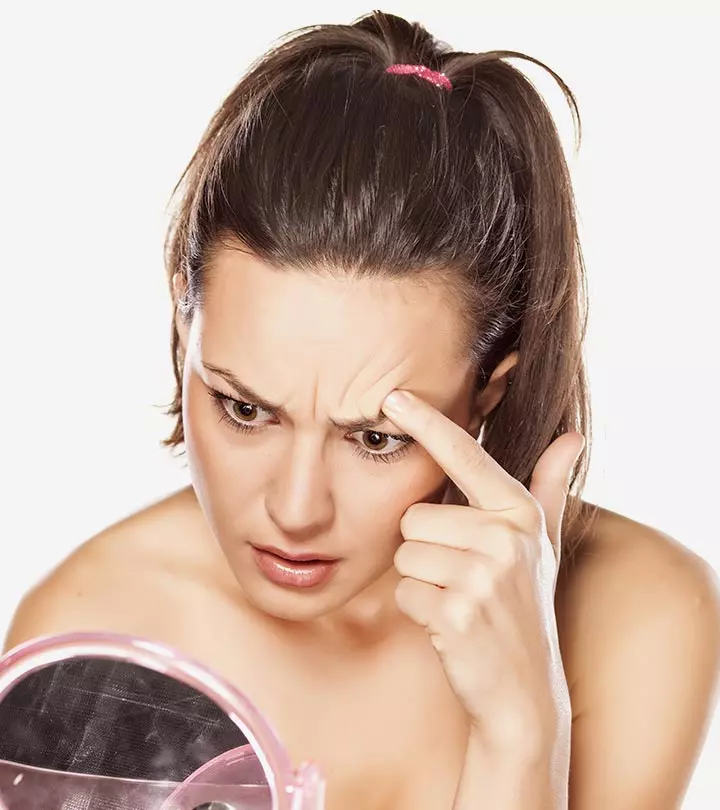
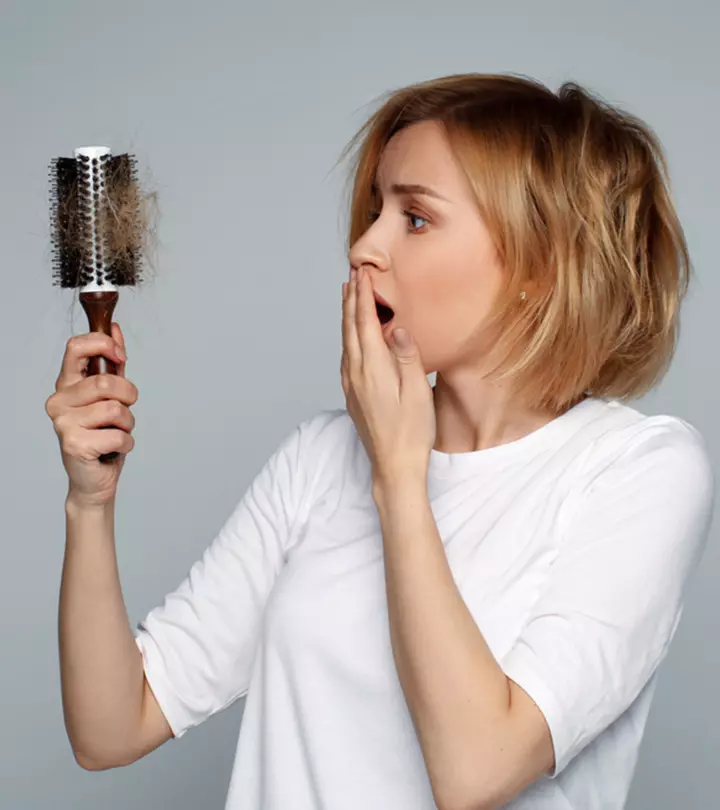

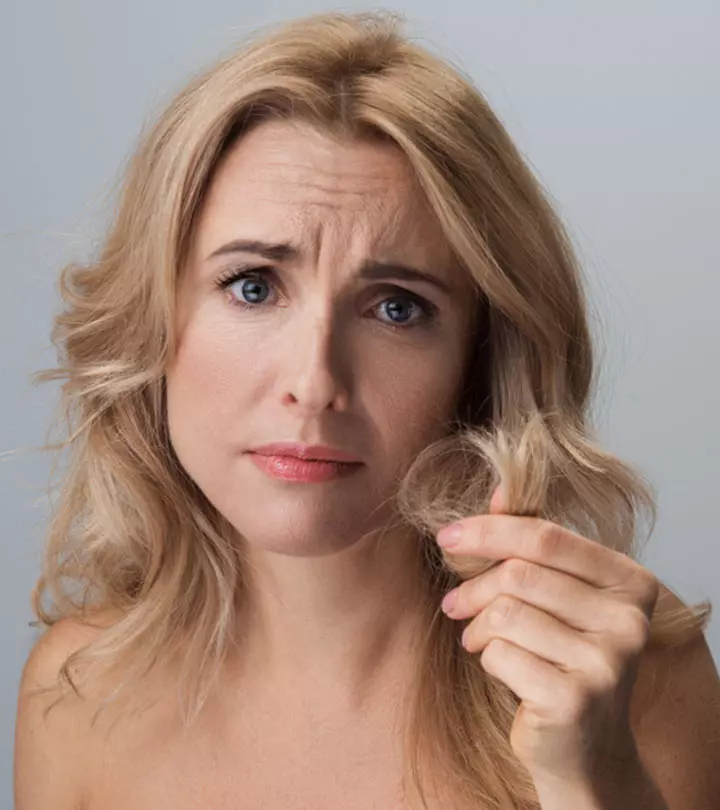
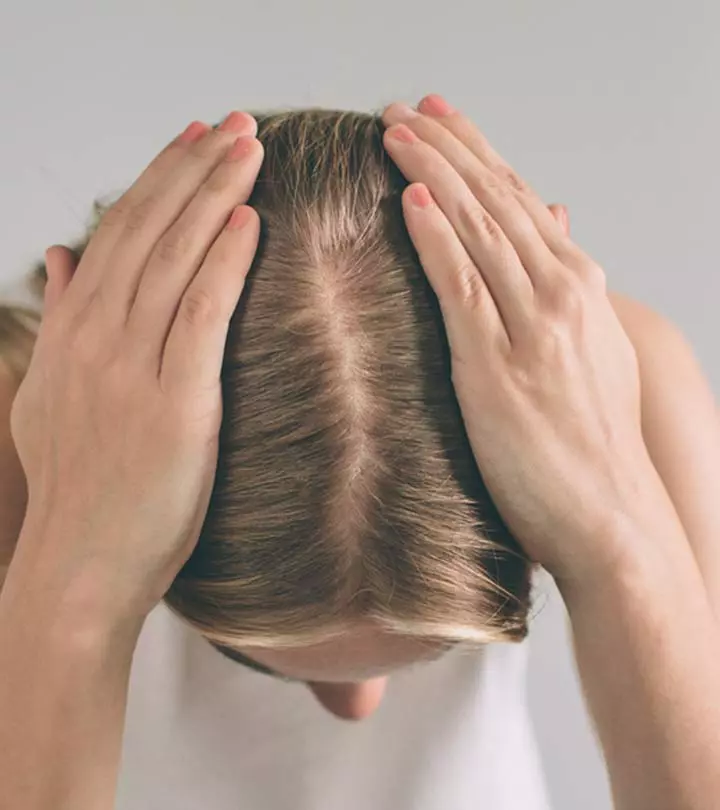

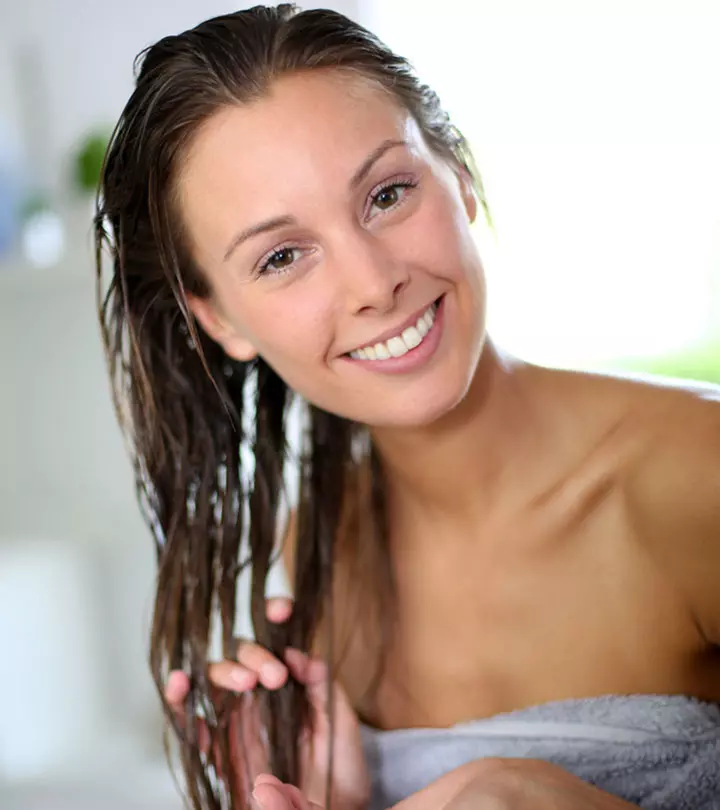
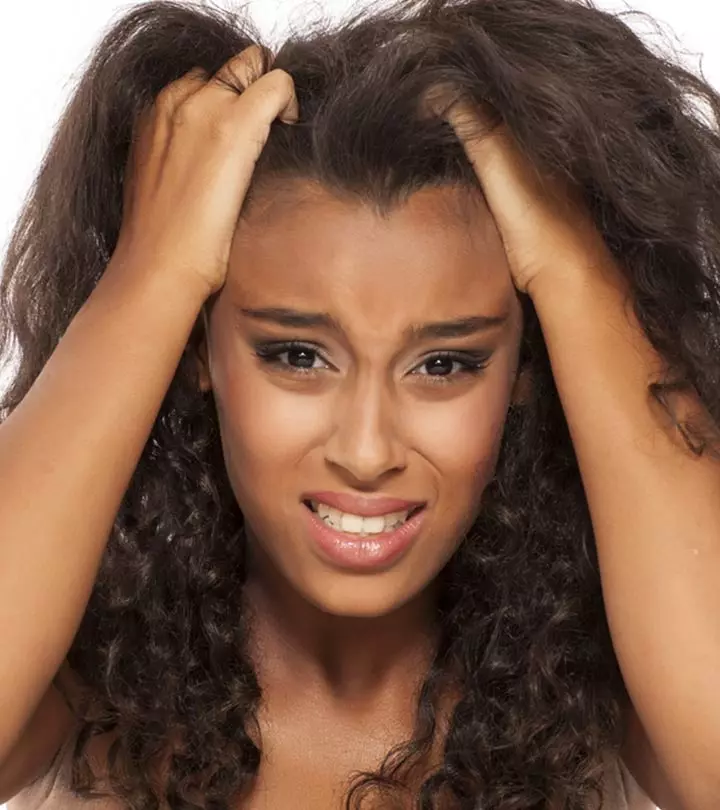
Community Experiences
Join the conversation and become a part of our empowering community! Share your stories, experiences, and insights to connect with other beauty, lifestyle, and health enthusiasts.